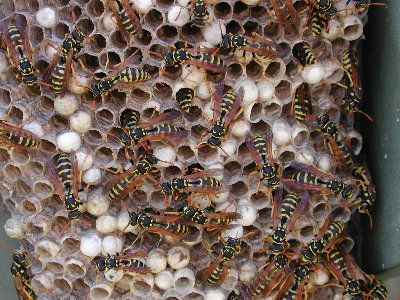

Family: Vespidae; Order: Hymenoptera)
 |
Bugs Around Your House
|
 |
|
European paper wasps
|
||
|
(Scientific
name: Polistes dominulus;
Family: Vespidae; Order: Hymenoptera) |
Description European paper wasps can be easily mistaken for yellow jackets. Both are about 3/4 inch long and slender. Like yellowjackets, this paper wasp has a yellow and black pattern on the abdomen. Yellowjackets are in a different subfamily (Vespinae) from the paper wasps (subfamily Polistinae). To tell them apart, look for the paper wasp's thin waist (or petiole, the first segment of the abdomen is much smaller than the rest) and yellow or orange colored antennae. Yellowjackets have black antennae and some hair on the thorax (the first body section behind the head). Paper wasps fly with their legs hang down; yellowjackets fly with their legs retracted. Yellowjackets almost invariably nest underground in soil. Their nests have a paper envelope surrounding multiple layers of brood cells. Paper wasps usually nest in the open or in crevices, almost never in soil. Their nest consists of a single disk hanging vertically with one layer of cells (although I have seen a few attached sideways to a transformer box).
|
Above: three queens wintering inside the black cardboard boxes used to protect bee hives during winter. Right: partial view of a mature nest during July, with more than 200 workers. Photos by Zachary Huang. |
 |
Distribution European paper wasps are native to Europe and Asia. The species was introduced into North American during the late 1970s. Since its discovery in Massachusetts, it has moved westward slowly in the past 20 years. It was not very common in Michigan before 1999, but now it is nesting everywhere and seems to be out competing the original paper wasp species (Polistes fascatus), which is gray, not as productive (thus not as common) and not as aggressive (thus fewer stinging incidents).
Behavior and biology Paper wasps in temperate climates have an annual cycle, similar to that of yellowjackets and bumble bees. Fertilized females (queens) from the previous year construct new nests in April and May in Michigan. The queens overwinter in protected areas such as in the cracks on a deck, inside wrappings of honey bee hives, or under the siding of a house. A single queen usually starts a new nest, but occasionally will use an old one. The queen forages for caterpillars or other insects, chews them up, and feeds them to the larvae, which have no legs and stay inside their hexagonal cells, totally dependent upon adults for food and care. Once the first batch of workers emerges as adults, the queen retires from foraging and stays home as a fulltime mother. Each batch of workers takes about 40 days to complete development, so by the time in July, the nest can be quite large and may have up to 400 workers (photo on right). They nest anywhere theyt can find a shelter: under eaves of houses, underneath satellite dishes, inside vent pipes, in electric switch boxes, etc. etc. The wasps are not as aggressive as yellowjackets, but are far more aggressive than the native paper wasps. Most stinging incidents occur because they nest where we do not expect to find them and thus are poorly prepared for their attack.
Control and prevention Because these wasps prey on other insects, if they are not bothering you or not nesting close to your house, they might be doing a good job getting rid of pest insects in your garden. To minimize their presence around your property, try to limit suitable nest sites for them. Seal holes in walls, put screens on vents and remove old nests in structures. Concentrate your efforts on nest removal and spraying early in Michigan before the end of May. It is easier to kill one queen than to kill 400 workers later. If a nest is large with many workers on it, wait until dark (workers would all be home and also cannot fly in darkness), then use a hornet or wasp spray to reach the nest. If they are nesting inside a cavity and you cannot precisely locate the nest, apply dusts at the entrance or pump the dust inside. If you are allergic to insect stings, have someone help you, or call a pest control firm listed in your yellow pages.
Disclaimer: This fact sheet is for information only. Mention of products does
not indicate endorsement. Prepared by Zachary Huang, Department of Entomology,
Michigan State University, East Lansing, MI 48824, USA. Email: bees@msu.edu.
url: http://cyberbee.msu.edu/column/stinging/euro-paperwasp.pdf